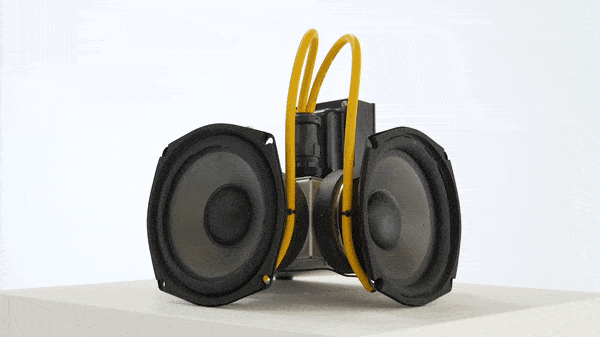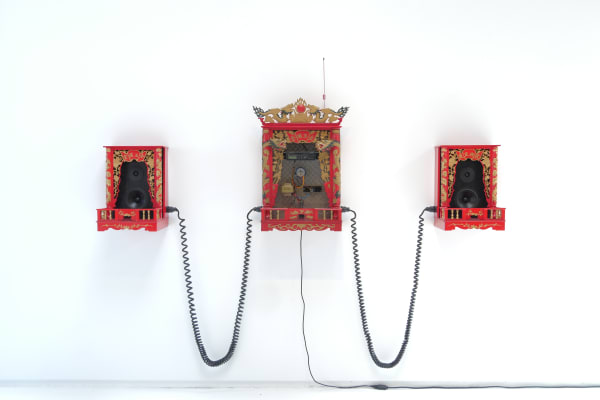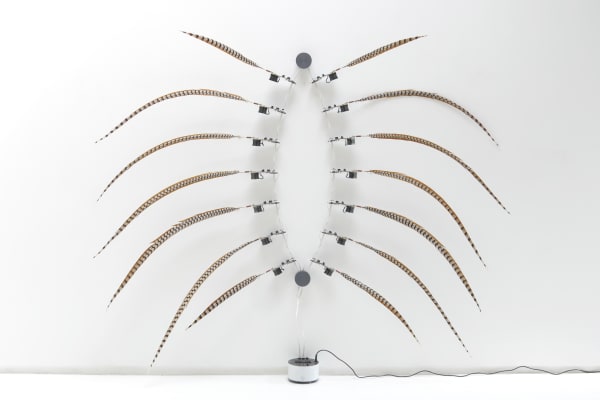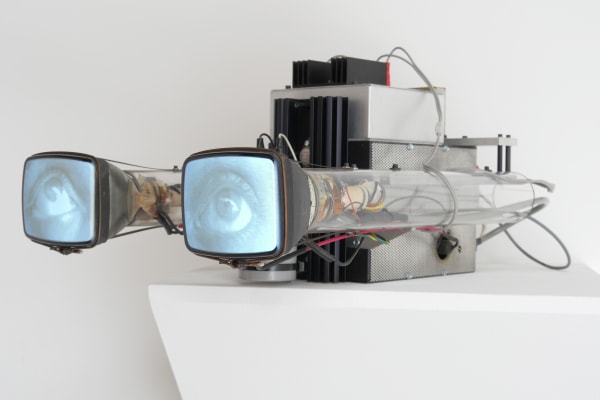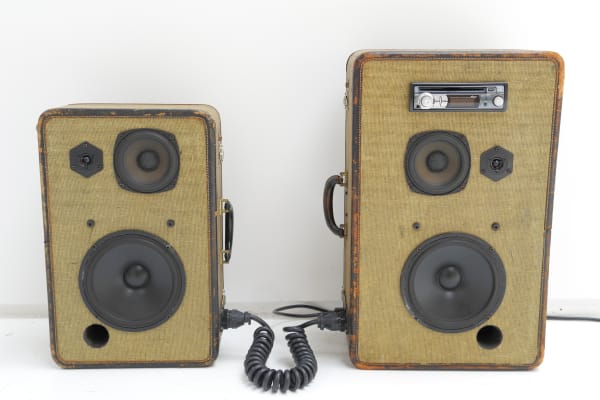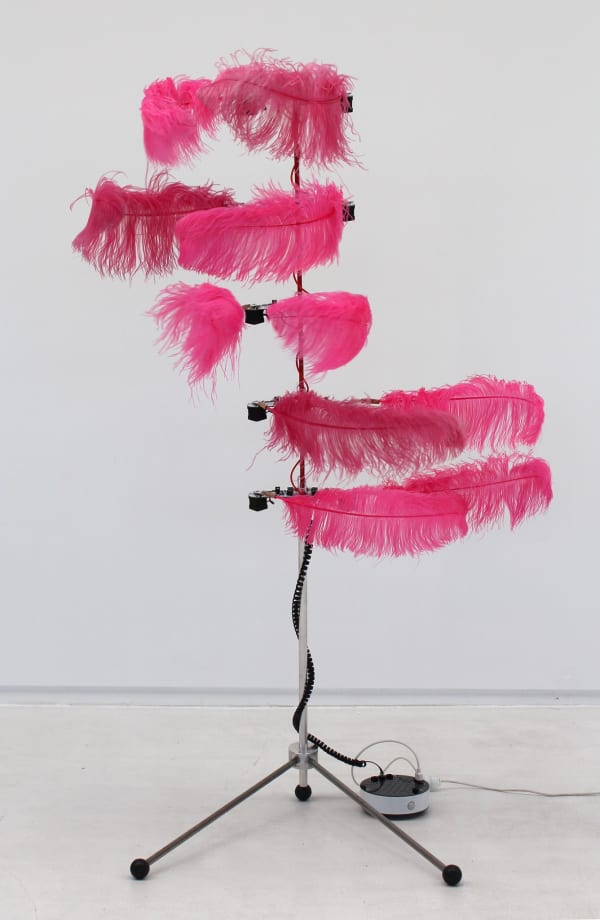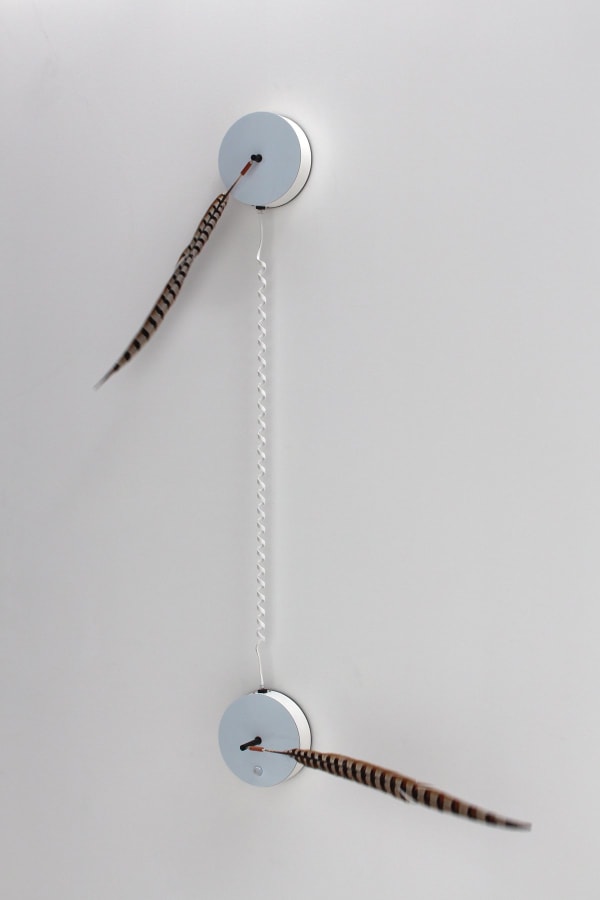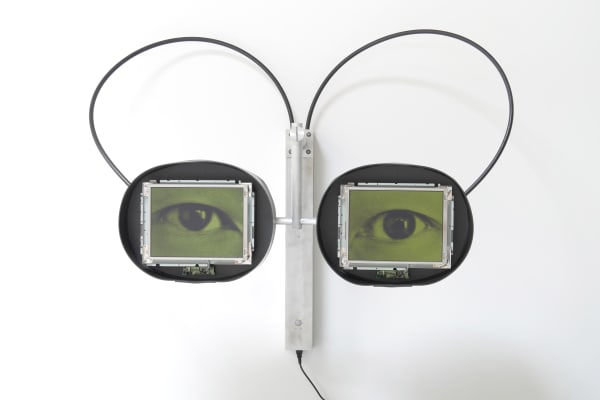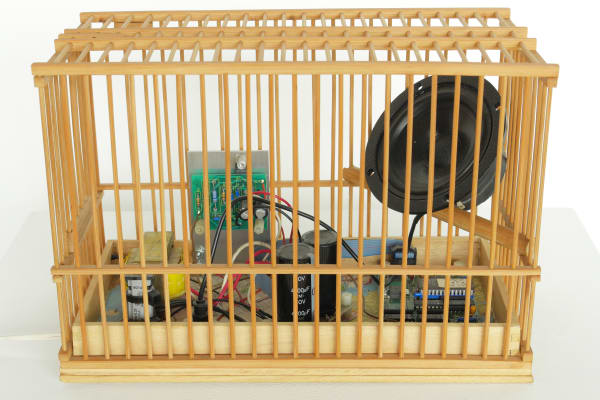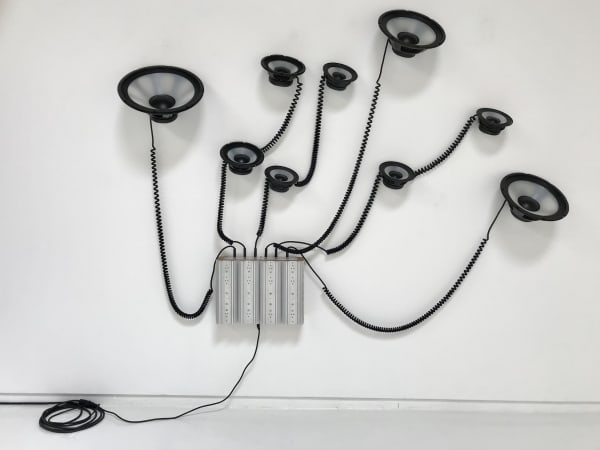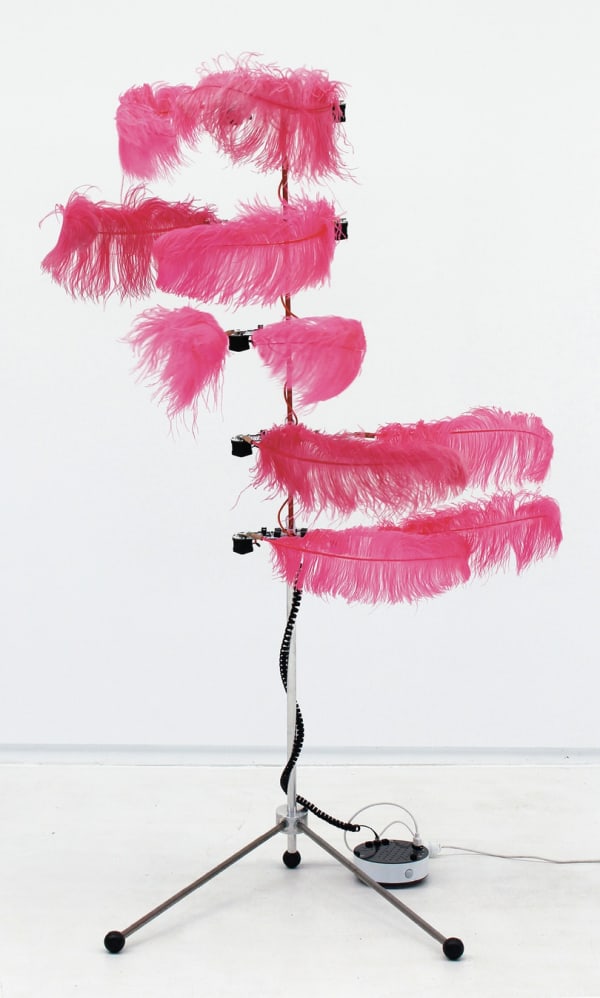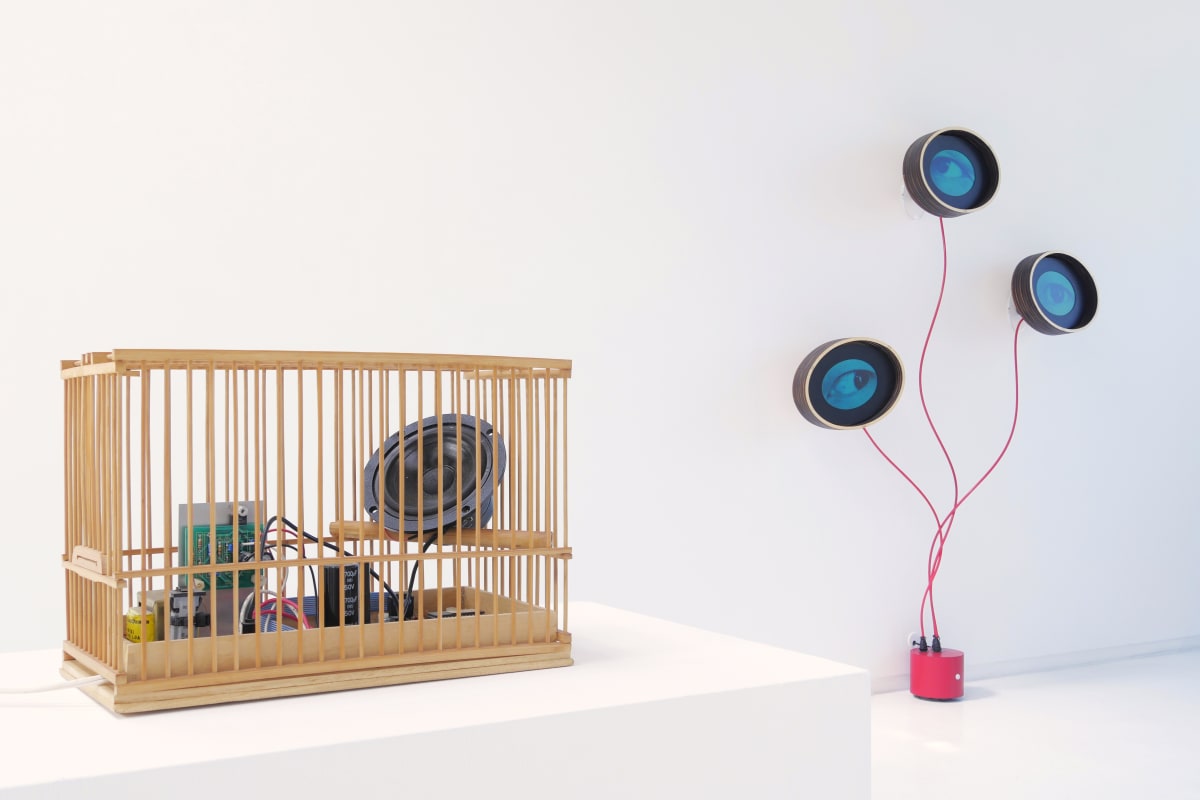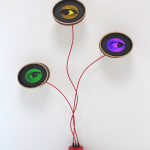Alan Rath
In formally elegant yet winsome sculptures — almost every component of which he designed, machined, and programed himself — Alan Rath explored the relationship between technology and the human body and behavior. In this exhibition, Hosfelt Gallery surveys the 35-year oeuvre of the sculptor and electronic art pioneer, who died in October of 2020 at age 60. Spanning the entirety of the artist’s career and incorporating every type of work he made, this encyclopedic show navigates the breadth of an extraordinary practice.
Beginning in 1985, Rath made work with technical materials like aluminum, steel, wires, and circuitry, in combination with cathode ray tubes displaying computer-generated video animations of body parts — roving eyes, waving hands, or lips with protruding and wagging tongues. Some pieces incorporated found elements like metal cages, wooden crates, or a photographer’s tripod. In all of these early works, their inner workings are, somewhat indecently, exposed.
By 1988, he began making sculptures with audio speakers, fascinated more by their motion than their ability to transmit sound; their movement uncannily simulates breathing as they puff, pant, vibrate, wheeze and throb. His passion for numbers led to pieces that endlessly count, or recite π, or function as calendars or clocks. He programmed his robotic works with open-ended algorithms, so the sculptures constantly modify their own choreography. A piece from 1998 successfully anticipated driverless car technology by 20 years.
Though Rath’s works are revolutionary in their masterful blend of high tech with high art, the technology is always subservient to the form or concept of the sculpture itself. The works possess a charming humility, without a hint of bravado advertising Rath’s unquestionable technical proficiency. Every material and design decision is considered and impeccable. Nothing is there just for looks, yet nothing, no matter how functional, isn’t beautiful.
“Machinery is not unnatural,” Rath said in an interview. “It’s a reflection of the people who make it.”
Alan Rath was born in Cincinnati, Ohio in 1959 and earned a BS in Electrical Engineering from the Massachusetts Institute of Technology in 1982. While at MIT he took courses within the Architecture Machine Group – the precursor to the Media Lab – and studied with Otto Piene (a co-founder of the Zero art group) at the Center for Advanced Visual Studies. His early influences include Alexander Calder, David Smith, Robert Moog, Jimi Hendrix, and NASA. In 1983, he moved to the San Francisco Bay Area, which was his home until he died.
Rath’s work has been exhibited extensively internationally, including a 2019 retrospective exhibition, Virtual Unreality, organized by the Institute of Contemporary Art, San Jose. Published in conjunction with the show is a catalog raisonné with an accompanying augmented reality application that enables the viewer to animate the robotic sculptures pictured in the book. In 1991 Rath’s work was included in the Whitney Biennial. The same year, he was the subject of a solo exhibition organized by the Walker Art Center, which traveled to the Museum of Contemporary Art, Chicago; the Institute of Contemporary Art, Philadelphia; the Center for Fine Art, Miami; and The Contemporary Museum, Honolulu. Other solo museum exhibitions include Hiroshima City Museum of Contemporary Art; Contemporary Arts Museum, Houston; Aspen Art Museum; SITE Santa Fe; and Austin Museum of Art. In 1994 Rath received a John Simon Guggenheim Memorial Foundation Fellowship grant. His works are in the collections of the Cincinnati Art Museum, the Berkeley Art Museum and Pacific Film Archive, the Los Angeles County Museum of Art, the San Francisco Museum of Modern Art, the San Jose Museum of Art, the Walker Art Center, the Whitney Museum of American Art, and many others.
-

-

-
 Alan Rath5 O'Clock, 2002aluminum, custom electronics, LCDs60 x 72 x 9 1/2 in
Alan Rath5 O'Clock, 2002aluminum, custom electronics, LCDs60 x 72 x 9 1/2 in
152.4 x 182.9 x 24.1 cm -

-

-
 Alan RathEyeris IX, 2017birch plywood, acrylic, polyethylene, aluminum, custom electronics, LCDs87 x 60 x 10 in
Alan RathEyeris IX, 2017birch plywood, acrylic, polyethylene, aluminum, custom electronics, LCDs87 x 60 x 10 in
221 x 152.4 x 25.4 cm -
 Alan RathForever, 2012fiberglass, PVC, Delrin, aluminum, motors, custom electronics, pheasant feathers84 x 108 x 48 in
Alan RathForever, 2012fiberglass, PVC, Delrin, aluminum, motors, custom electronics, pheasant feathers84 x 108 x 48 in
213.4 x 274.3 x 121.9 cm -
 Alan RathFramed Running Man, 2004Garolite XX, PVC, G-10, wood, paper, software, electronics, LCD25 x 21 x 3 in
Alan RathFramed Running Man, 2004Garolite XX, PVC, G-10, wood, paper, software, electronics, LCD25 x 21 x 3 in
63.5 x 53.3 x 7.6 cm -

-

-
 Alan RathLittle Pi 200, 1996aluminum, acrylic, custom electronics, LEDs14 x 12 x 2 in
Alan RathLittle Pi 200, 1996aluminum, acrylic, custom electronics, LEDs14 x 12 x 2 in
35.6 x 30.5 x 5.1 cm -

-

-

-

-

-

-

-

-

-

-
 Alan RathRunning Man On Chinese Stand II, 2015wood, acrylic, Delrin, Garolite, aluminum, polypropylene, custom electronics, LCD23 x 15 x 15 in
Alan RathRunning Man On Chinese Stand II, 2015wood, acrylic, Delrin, Garolite, aluminum, polypropylene, custom electronics, LCD23 x 15 x 15 in
58.4 x 38.1 x 38.1 cm -

-

-

-

-

-

-
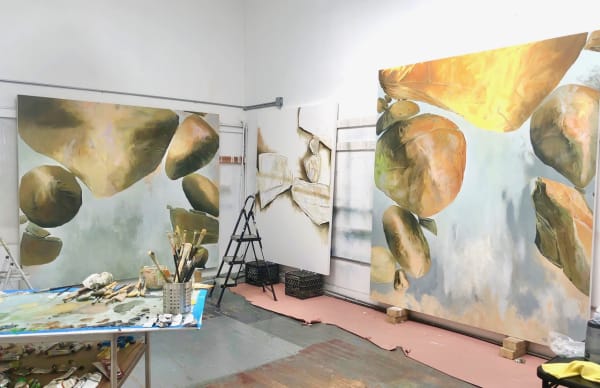
HG Magazine Issue no. 32
Judith Belzer joins the gallery; plus Rina Banerjee, Alan Rath, pi(e) July 20, 2021Introducing Judith Belzer Rina Banerjee & Rachel Kent: Conversation Recap An Artwork Explained: Alan Rath's Huge Pi 808 We Recommend: Pi(e)Read more -
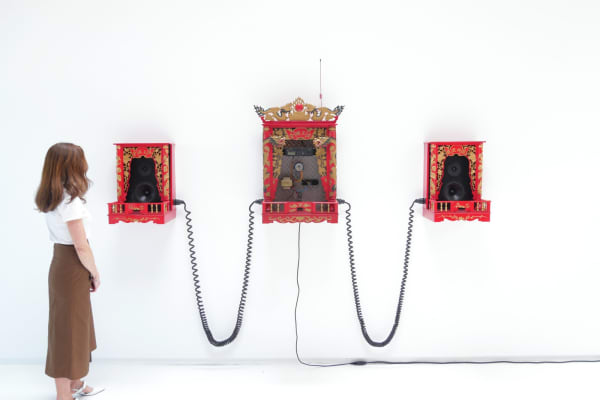
HG Magazine Issue no. 31
Alan Rath exhibition opens; plus Rina Banerjee, Cornelius Völker, Nicole Phungrasamee Fein June 11, 2021Alan Rath opens June 19, 2021 Jim Campbell remembers Alan Rath Artist News: Rina Banerjee, Cornelius Völker New to Inventory: Nicole Phungrasamee Fein Whitney Museum...Read more




